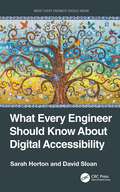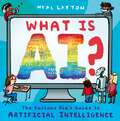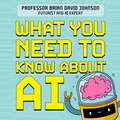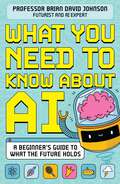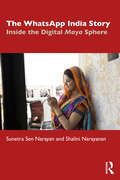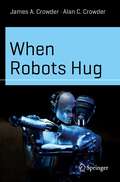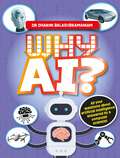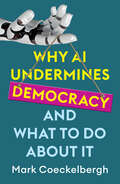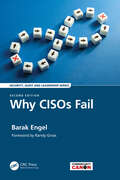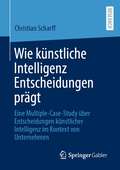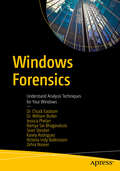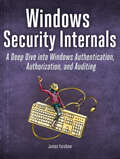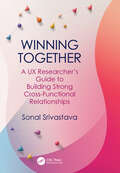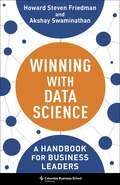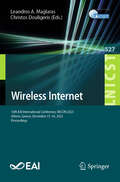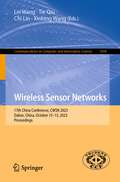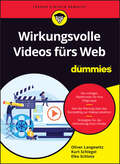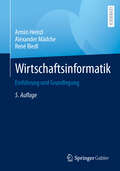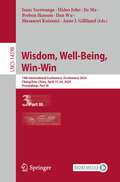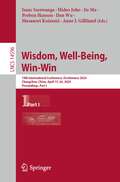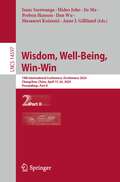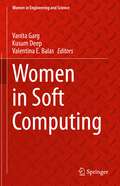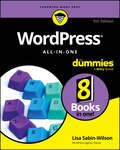- Table View
- List View
What Every Engineer Should Know About Digital Accessibility (ISSN)
by Sarah Horton David SloanAccessibility is a core quality of digital products to be deliberately addressed throughout the development lifecycle. What Every Engineer Should Know About Digital Accessibility will prepare readers to integrate digital accessibility into their engineering practices. Readers will learn how to accurately frame accessibility as an engineering challenge so they are able to address the correct problems in the correct way.Illustrated with diverse perspectives from accessibility practitioners and advocates, this book describes how people with disabilities use technology, the nature of accessibility barriers in the digital world, and the role of engineers in breaking down those barriers. Accessibility competence for current, emerging, and future technologies is addressed through a combination of guiding principles, core attributes and requirements, and accessibility‑informed engineering practices.FEATURES Discusses how technology can support inclusion for people with disabilities and how rigorous engineering processes help create quality user experiences without introducing accessibility barriers Explains foundational principles and guidelines that build core competency in digital accessibility as they are applied across diverse and emerging technology platforms Highlights practical insights into how engineering teams can effectively address accessibility throughout the technology development lifecycle Uses international standards to define and measure accessibility quality Written to be accessible to non‑experts in the subject area, What Every Engineer Should Know About Digital Accessibility is aimed at students, professionals, and researchers in the field of software engineering.
What is AI?: The curious kid's guide to artificial intelligence
by Neal LaytonAn easy-to-understand picture book explaining AI to young readers, whilst celebrating how amazing human brains really are!Everyone is talking about artificial intelligence - and we all have LOTS of questions. What exactly is it? Why is it such a big deal? Are there any risks? And how is it going to transform our lives?Award-winning author-illustrator Neal Layton is here to explain all there is to know about AI, from the early computers that could only solve sums to the AI programs of today that can recognise human speech and recommend TV shows - and what AI might be able to do in the future. Along the way, readers will learn just how incredible their human brains really are, and what intelligence is all about.This entertaining non-fiction picture book, illustrated in Neal Layton's trademark zany collage style, is perfect for readers aged 6+ who are always asking HOW something works, and for parents wanting to help their kids make sense of a subject that everyone is talking about.
What You Need to Know About AI: A beginner’s guide to what the future holds
by Brian David JohnsonThe only book you need on AI - for all curious, fact-gobbling kids age 7+.What actually is AI? Will it take over the world? And one day, will it tidy your bedroom...? In this beginner's guide, learn everything you need to know about AI, from how it helps us discover epic stuff up in space or under the sea, whether it will help you build your very own dinosaur, and why, it won't actually help you write your homework! Written by AI expert and Futurist, Brian David Johnson, you will learn what AI is, where it came from, and how it's already being used in the world of sport, space, medicine, animals and more. You will discover AI's amazing possibilities that might shape the future. And along the way, you'll learn super cool facts, bust some myths, and gain a balanced and informed view on the biggest topic of our time.Designed with fun line illustrations throughout.
What You Need to Know About AI: A beginner’s guide to what the future holds
by Brian David JohnsonThe only book you need on AI - for all curious, fact-gobbling kids.What actually is AI? Will it take over the world? And one day, will it tidy your bedroom . . .? In this beginner's guide, learn everything you need to know about AI, from how it helps us discover epic stuff up in space or under the sea to whether it might help you build your own dinosaur.With AI expert and futurist Brian David Johnson, discover what AI is, where it came from, the incredible ways it's being used today and how it might shape and reimagine your future. Learn that AI is just software and that it won't replace human creativity or imagination, but it could help us do some really cool things. And uncover amazing facts, myth busters and insight from experts around the world!This book offers a balanced, expert and fascinating view on the biggest topic of our time. Designed with fun illustrations throughout.
The WhatsApp India Story: Inside the Digital Maya Sphere
by Sunetra Sen Narayan Shalini NarayananWhatsApp is used by over half a billion people in India today in all fields – in business, corporate and informal sectors, in government, for education and among friends, families and acquaintances. This book critically explores the social messaging app’s rapid expansion in India and its growing influence and looks at whether, as a form of horizontal communication, it poses a challenge to more traditional structures of communication. The book examines WhatsApp’s spread in the personal and professional lives of Indians and the myriad ways in which people in India are using the app in social and business interactions, including among people living with disabilities. Using case studies, interviews, surveys and in-depth research, it analyses key aspects of WhatsApp’s massive popularity and its impact on how people communicate. It also explores its impact on the psycho-social dynamics in India, including the dissemination of fake news and politically motivated content, and the consequent need for media regulation in the country. One of the first books to analyse the pervasiveness of WhatsApp and social media apps in different areas of Indian society, this book will be of interest to scholars and students of media studies, communication studies, digital media, cultural studies, cyberculture studies, sociology and social policy and media law.
When Robots Hug (Science and Fiction)
by James A. Crowder Alan C. CrowderBy 2027, it had been seven years since the scientists’ sea-changing research on artificial psychology and robotics. The work debuted around the same time as Large Language Model Chatbots, and the power of the integration of the two technologies put many industries in a tailspin. The commercial and defense industries especially were still scrambling to regulate their use in research and universities. The sought-after scientists signed with DARPA to build reliable and secure AI entities, but the agency grew fearful of the technology’s power and ultimately decided it was too dangerous to bring to market and demanded the scientists destroy the work. The researchers couldn’t bring themselves to discard 20 years of research, so instead sent the entities to various research labs around the world. But unbeknownst to them, each AI-entity embraced its new home, growing, adapting, evolving, and ultimately connecting beyond what the researchers could envision. In the end, as the scientists catch up to each one, they realize the entities have discovered a very human means of interacting: the power of physical contact; and not physical contact between humans and technology, but physical contact between robotic entities. And with this discovery, the entities join forces to only grow stronger. This development ushers in a new paradigm where the difference between AI-entities and human entities becomes less and less discernible. All the AI and robotic science featured in the book is real; the story line is fictional, but with how fast innovation moves, it’s not hard to envision.
Why AI?: All your questions about artificial intelligence answered by a computer scientist
by Dr Dharini BalasubramaniamAll your questions and worries about Al today - the who, what, where, when and WHY - answered by a computer scientist.It's here and it's not going away - AI is on everyone's mind, but many of us don't know what it is never mind what to think about it! Why AI? is a question-and-answer based exploration of the topic for ages 8 and up, from Dr Dharini Balasubramaniam, a computer scientist at University of St Andrews and a passionate advocate for ethics and education in her field. Dr Balasubramaniam's clear and balanced explanations put our mind at ease, while challenging readers to consider how far AI can and should go in certain areas. She introduces us to the history of the concept of machine learning, the pioneers in the field of AI and the amazing AI doing good in the world today. The book includes case studies on fascinating topics, such as search-engine AI and exciting robotics, and answers questions, such as: What did AI start?; Why do we need AI?; What can AI DO?; What should AI do?; What is the future of AI?
Why AI Undermines Democracy and What To Do About It
by Mark CoeckelberghAcross the world, AI is used as a tool for political manipulation and totalitarian repression. Stories about AI are often stories of polarization, discrimination, surveillance, and oppression. Is democracy in danger? And can we do anything about it? In this compelling and balanced book, Mark Coeckelbergh reveals the key risks posed by AI for democracy. He argues that AI, as currently used and developed, undermines fundamental principles on which liberal democracies are founded, such as freedom and equality. How can we make democracy more resilient in the face of AI? And, more positively, what can AI do for democracy? Coeckelbergh advocates not only for more democratic technologies, but also for new political institutions and a renewal of education to ensure that AI promotes, rather than hinders, the common good for the twenty-first century. Why AI Undermines Democracy and What to Do About It is illuminating reading for anyone who is concerned about the fate of democracy.
Why CISOs Fail: The Missing Link In Security Management--and How To Fix It (Security, Audit and Leadership Series)
by Barak EngelReleased in 2017, the first edition of Why CISOs Fail reimagined the role of the Chief Information Security Officer in a new and powerful way. Written to be easily consumable by both security pros as well as everyone who must deal with them, the book explores the different realms in which security leaders fail to deliver meaningful impact to their organizations, and why this happens. Its central thesis—that security is primarily a human behavioral discipline rather than a technology one—has been gaining increased attention as a core tenet of the field, and the book was ultimately inducted into the cybersecurity canon as a leading book on security management.In this freshly updated edition, Barak Engel adds new sections that correspond with the chapters of the original book: security as a discipline; as a business enabler; in sales; in legal; in compliance; in technology; and as an executive function. He explores new ideas in each operational area, providing essential insights into emerging aspects of the discipline. He then proposes two critical concepts for security management—the concept of "digital shrinkage" and the transition from CISO to CI/SO—that together offer a new paradigm for any organization that wants to become truly successful in its security journey.Why CISOs (Still) Fail is delivered in Barak's conversational, humoristic style, that has attracted a global audience to this and his other book, The Security Hippie. As he notes, the book's goal is to entertain as much as to inform, and he dearly hopes that you have fun reading it.
Wie künstliche Intelligenz Entscheidungen prägt: Eine Multiple-Case-Study über Entscheidungen künstlicher Intelligenz im Kontext von Unternehmen
by Christian ScharffViele Organisationstheorien schließen Technik aus der sozialen Welt aus. Dies wird durch lernfähige Algorithmen infrage gestellt, deren Output sich nicht vollständig auf Menschen zurückrechnen lässt. Es ist deshalb notwendig, die Beziehung von Organisation und künstlicher Intelligenz ergebnisoffen zu untersuchen und zu erklären. Das vorliegende Buch analysiert zu diesem Zweck auf Grundlage einer Multiple-Case-Study, auf welche Weise, aus welchen Gründen und mit welchen Folgen künstliche Intelligenz an den Entscheidungen von Unternehmen beteiligt ist. Es stellt sich heraus, dass die Technik als Entscheidungsträger aktiv an Organisationen teilnehmen und deren strukturelles Fundament prägen kann. Dabei handelt es sich jedoch nur um eine von drei Erscheinungsformen künstlicher Intelligenz. Inwieweit KI-Anwendungen tatsächlich Gelegenheit erhalten, Entscheidungen zu treffen, bestimmen Organisationen nach eigenen Maßgaben.
Windows Forensics: Understand Analysis Techniques for Your Windows
by William Butler Chuck Easttom Jessica Phelan Ramya Sai Bhagavatula Sean Steuber Karely Rodriguez Victoria Indy Balkissoon Zehra NaseerThis book is your comprehensive guide to Windows forensics. It covers the process of conducting or performing a forensic investigation of systems that run on Windows operating systems. It also includes analysis of incident response, recovery, and auditing of equipment used in executing any criminal activity.The book covers Windows registry, architecture, and systems as well as forensic techniques, along with coverage of how to write reports, legal standards, and how to testify. It starts with an introduction to Windows followed by forensic concepts and methods of creating forensic images. You will learn Windows file artefacts along with Windows Registry and Windows Memory forensics. And you will learn to work with PowerShell scripting for forensic applications and Windows email forensics. Microsoft Azure and cloud forensics are discussed and you will learn how to extract from the cloud. By the end of the book you will know data-hiding techniques in Windows and learn about volatility and a Windows Registry cheat sheet.What Will You LearnUnderstand Windows architectureRecover deleted files from Windows and the recycle binUse volatility and PassMark volatility workbenchUtilize Windows PowerShell scripting for forensic applicationsWho This Book Is ForWindows administrators, forensics practitioners, and those wanting to enter the field of digital forensics
The Windows Screen Reader Primer: All the Basics and More
by David KingsburyThe "Windows Screen Reader Primer: Third Edition" offers comprehensive guidance for users of JAWS, NVDA, and Windows Narrator, focusing on essential Windows applications, Office Suite tools, web browsers, cloud-based platforms, PDF readers, and teleconferencing software. With updates for Windows 11 and recent software versions, it includes new chapters on Google Workspace, audio-video editing, and AI integration. The book caters to beginners and intermediate users, providing step-by-step instructions, customizable settings, and practical exercises. Accessible formats and navigation tips enhance usability, making it an invaluable resource for mastering screen reader usage in the Windows environment.
Windows Security Internals: A Deep Dive into Windows Authentication, Authorization, and Auditing
by James ForshawPower up your Windows security skills with expert guidance, in-depth technical insights, and dozens of real-world vulnerability examples from Google Project Zero&’s most renowned researcher! Learn core components of the system in greater depth than ever before, and gain hands-on experience probing advanced Microsoft security systems with the added benefit of PowerShell scripts.Windows Security Internals is a must-have for anyone needing to understand the Windows operating system&’s low-level implementations, whether to discover new vulnerabilities or protect against known ones. Developers, devops, and security researchers will all find unparalleled insight into the operating system&’s key elements and weaknesses, surpassing even Microsoft&’s official documentation.Author James Forshaw teaches through meticulously crafted PowerShell examples that can be experimented with and modified, covering everything from basic resource security analysis to advanced techniques like using network authentication. The examples will help you actively test and manipulate system behaviors, learn how Windows secures files and the registry, re-create from scratch how the system grants access to a resource, learn how Windows implements authentication both locally and over a network, and much more.You&’ll also explore a wide range of topics, such as:Windows security architecture, including both the kernel and user-mode applicationsThe Windows Security Reference Monitor (SRM), including access tokens, querying and setting a resource&’s security descriptor, and access checking and auditingInteractive Windows authentication and credential storage in the Security Account Manager (SAM) and Active DirectoryMechanisms of network authentication protocols, including NTLM and KerberosIn an era of sophisticated cyberattacks on Windows networks, mastering the operating system&’s complex security mechanisms is more crucial than ever. Whether you&’re defending against the latest cyber threats or delving into the intricacies of Windows security architecture, you&’ll find Windows Security Internals indispensable in your efforts to navigate the complexities of today&’s cybersecurity landscape.
Winning Together: A UX Researcher's Guide to Building Strong Cross-Functional Relationships
by Sonal SrivastavaUX research, the key to comprehending users' behaviors, motivations, and preferences for developing delightful experiences, thrives on effective teamwork and collaboration. This comprehensive guide brings together the expertise and insights from seasoned researchers, cross-functional partners, and product leaders in order to transform how you collaborate and unlock the true potential of UX research. Key Features Includes a comprehensive selection of ready-to-use templates Incorporates insights and advice from cross-functional stakeholders Offers a wide range of strategies tailored to various expertise levels, catering to both novice and advanced practitioners Presents universally applicable methodologies and insights, equipping a diverse range of researchers, including consultants, vendors, and in-house professionals From experienced professionals to those just starting out, and freelancers to in-house researchers, this comprehensive guide offers practical strategies to navigate the pitfalls of UX research, enhancing collaboration and, ultimately, driving success.
Winning with Data Science: A Handbook for Business Leaders
by Howard Steven Friedman Akshay SwaminathanWhether you are a newly minted MBA or a project manager at a Fortune 500 company, data science will play a major role in your career. Knowing how to communicate effectively with data scientists in order to obtain maximum value from their expertise is essential. This book is a compelling and comprehensive guide to data science, emphasizing its real-world business applications and focusing on how to collaborate productively with data science teams.Taking an engaging narrative approach, Winning with Data Science covers the fundamental concepts without getting bogged down in complex equations or programming languages. It provides clear explanations of key terms, tools, and techniques, illustrated through practical examples. The book follows the stories of Kamala and Steve, two professionals who need to collaborate with data science teams to achieve their business goals. Howard Steven Friedman and Akshay Swaminathan walk readers through each step of managing a data science project, from understanding the different roles on a data science team to identifying the right software. They equip readers with critical questions to ask data analysts, statisticians, data scientists, and other technical experts to avoid wasting time and money. Winning with Data Science is a must-read for anyone who works with data science teams or is interested in the practical side of the subject.
Wireless Internet: 16th EAI International Conference, WiCON 2023, Athens, Greece, December 15-16, 2023, Proceedings (Lecture Notes of the Institute for Computer Sciences, Social Informatics and Telecommunications Engineering #527)
by Leandros A. Maglaras Christos DouligerisThis book constitutes the refereed post-conference proceedings of the 16th International Conference on Wireless Internet, WiCON 2023, held in Athens, Greece, in December 15-16, 2023. The 14 full papers were selected from 35 submissions and are grouped into the following topics: Wireless networks; AI/ML systems; 5G/6G networks; and Digital services.
Wireless Sensor Networks: 17th China Conference, CWSN 2023, Dalian, China, October 13–15, 2023, Proceedings (Communications in Computer and Information Science #1994)
by Lei Wang Tie Qiu Chi Lin Xinbing WangThis book constitutes the refereed proceedings of the 17th China Conference on Wireless Sensor Networks, CWSN 2023, which took place in Dalian, China, in October 2023. The 22 full papers presented in this volume were carefully reviewed and selected from 105 submissions, including 38 English papers and 67 Chinese papers. The conference provided an academic exchange of research and a development forum for IoT researchers, developers, enterprises, and users. Exchanging results and experience of research and applications in IoT, and discussing the key challenges and research hotspots, is the main goal of the forum. As a high-level forum for the design, implementation, and application of IoT, the conference promoted the exchange and application of the theories and technologies of IoT-related topics.
Wirkungsvolle Videos fürs Web für Dummies (Für Dummies)
by Oliver Langewitz Kurt Schlegel Elke SchloteMithilfe von Videos das Netz begeistern Videos bieten Ihnen die Möglichkeit, eigene Ideen zu vermitteln oder Ihre Marke zu präsentieren. Wie Sie wirkungsvolle Videos fürs Web erstellen und was Sie bei der videobasierten Kommunikation beachten müssen, erfahren Sie in diesem Buch. Oliver Langewitz, Kurt Schlegel und Elke Schlote erklären Ihnen in praktischen Schritten, wie Ihnen die Planung, Erstellung und Verbreitung von Videos fürs Web optimal gelingt. Dabei lernen Sie auch die Besonderheiten der verschiedenen Internetplattformen kennen und wie Sie Ihre Zielgruppe mit Ihren Inhalten abholen. Sie erfahren Wie Sie professionelle Webvideos produzieren Wie Sie in Ihren Videos wirksame Geschichten erzählen Welche Online-Kanäle für Ihre Videos wichtig sind Wie es Ihnen gelingt, mit Ihren Videos eine breite Community zu erreichen
Wirtschaftsinformatik: Einführung und Grundlegung
by Alexander Mädche René Riedl Armin HeinzlDas Lehrbuch führt systematisch und grundlegend in die Wirtschaftsinformatik ein und behandelt die grundlegenden Phänomene der Wirklichkeit, ohne deren Vorhandensein und große praktische Bedeutung die Wirtschaftsinformatik als Wissenschaft und als wissenschaftliches Studium nicht existieren würde. Es beschreibt den Gegenstandsbereich, den Wissenschaftscharakter und die Wissenschaftsaufgaben sowie die Methoden, die zur Erklärung und Gestaltung verfolgt und verwendet werden. Es zeigt sowohl Zweck und Ziele der Wirtschaftsinformatik als auch grundlegende Phänomene wie Information und Kommunikation, Typen von Informationssystemen, Informationsinfrastruktur sowie Digitalisierung und digitale Transformation. Zudem wird die Rolle des Menschen als zentrales Element von Informationssystemen dargestellt. Das Buch richtet sich an Studierende und Lehrende in grundständigen Bachelor- und Masterprogrammen. Auch Schüler und Praktiker können anhand der Lektüre neue Erkenntnisse gewinnen.
Wisdom, Well-Being, Win-Win: 19th International Conference, iConference 2024, Changchun, China, April 15–26, 2024, Proceedings, Part III (Lecture Notes in Computer Science #14598)
by Isaac Sserwanga Hideo Joho Jie Ma Preben Hansen Dan Wu Masanori Koizumi Anne J. GillilandThe Three-volume set LNCS 14596, 14597 and 14598 constitutes the proceedings of the 19th International Conference on Wisdom, Well-Being, Win-Win, iConference 2024, which was hosted virtually by University of Tsukuba, Japan and in presence by Jilin University, Changchun, China, during April 15–26, 2024. The 36 full papers and 55 short papers are presented in these proceedings were carefully reviewed and selected from 218 submissions. The papers are organized in the following topical sections: Volume I: Archives and Information Sustainability; Behavioural Research; AI and Machine Learning; Information Science and Data Science; Information and Digital Literacy. Volume II: Digital Humanities; Intellectual Property Issues; Social Media and Digital Networks; Disinformation and Misinformation; Libraries, Bibliometrics and Metadata. Volume III: Knowledge Management; Information Science Education; Information Governance and Ethics; Health Informatics; Human-AI Collaboration; Information Retrieval; Community Informatics; Scholarly, Communication and Open Access.
Wisdom, Well-Being, Win-Win: 19th International Conference, iConference 2024, Changchun, China, April 15–26, 2024, Proceedings, Part I (Lecture Notes in Computer Science #14596)
by Isaac Sserwanga Hideo Joho Jie Ma Preben Hansen Dan Wu Masanori Koizumi Anne J. GillilandThe Three-volume set LNCS 14596, 14596 and 14598 constitutes the proceedings of the 19th International Conference on Wisdom, Well-Being, Win-Win, iConference 2024, which was hosted virtually by University of Tsukuba, Japan and in presence by Jilin University, Changchun, China, during April 15–26, 2024. The 36 full papers and 55 short papers are presented in these proceedings were carefully reviewed and selected from 218 submissions. The papers are organized in the following topical sections: Volume I: Archives and Information Sustainability; Behavioural Research; AI and Machine Learning; Information Science and Data Science; Information and Digital Literacy. Volume II: Digital Humanities; Intellectual Property Issues; Social Media and Digital Networks; Disinformation and Misinformation; Libraries, Bibliometrics and Metadata. Volume III: Knowledge Management; Information Science Education; Information Governance and Ethics; Health Informatics; Human-AI Collaboration; Information Retrieval; Community Informatics; Scholarly, Communication and Open Access.
Wisdom, Well-Being, Win-Win: 19th International Conference, iConference 2024, Changchun, China, April 15–26, 2024, Proceedings, Part II (Lecture Notes in Computer Science #14597)
by Isaac Sserwanga Hideo Joho Jie Ma Preben Hansen Dan Wu Masanori Koizumi Anne J. GillilandThe Three-volume set LNCS 14596, 14596 and 14598 constitutes the proceedings of the 19th International Conference on Wisdom, Well-Being, Win-Win, iConference 2024, which was hosted virtually by University of Tsukuba, Japan and in presence by Jilin University, Changchun, China, during April 15–26, 2024. The 36 full papers and 55 short papers are presented in these proceedings were carefully reviewed and selected from 218 submissions. The papers are organized in the following topical sections: Volume I: Archives and Information Sustainability; Behavioural Research; AI and Machine Learning; Information Science and Data Science; Information and Digital Literacy. Volume II: Digital Humanities; Intellectual Property Issues; Social Media and Digital Networks; Disinformation and Misinformation; Libraries, Bibliometrics and Metadata. Volume III: Knowledge Management; Information Science Education; Information Governance and Ethics; Health Informatics; Human-AI Collaboration; Information Retrieval; Community Informatics; Scholarly, Communication and Open Access.
Women and Film Animation: A Feminist Corpus at the National Film Board of Canada 1939-1989
by Marie-Josée Saint-PierreThe creations of female animation filmmakers are recognized all over the world while being, paradoxically, unknown to the general public. Women and Film Animation: A Feminist Corpus at the National Film Board of Canada 1939-1989 brings out of the shadows the work of true pioneers by presenting and analyzing, from a resolutely feminist perspective, the works they have conceived within the National Film Board of Canada (NFB).This institution has played an essential role in the emergence of animated cinema in Canada, but it is forgotten or ignored that a good part of this vast corpus is the work of women who have worked there not only as assistants but also as directors. These artists have contributed to changing the traditional representations of women in a unique way in both commercial and avant-garde animated cinema. The author accounts for their concerns, their creativity, and their many bright achievements. To do this, she relies on a wide range of critical works in social and cultural history of Canada, in feminist art history, and on multiple studies on animated cinema.Key Features: Provides an interdisciplinary approach that combines concepts from feminist studies, film theory and visual arts for a nuanced analysis of the role of women in animated cinema Discusses historical and sociological background that sheds light on the condition of women Includes a profound analysis of the changes and continuities in the role of women in this industry over time, focusing on the National Film Board of Canada Features previously unreleased archival material and selected excerpts from reviews by the NFB’s programming committee, highlighting the impact of production circumstances of the works of specific women animators
Women in Soft Computing (Women in Engineering and Science)
by Vanita Garg Kusum Deep Valentina E. BalasThis book gives a detailed information of various soft computing techniques across various fields for solving relevant, real-life problems. The authors, all female leaders in the field, show how soft computing uses approximate calculations to provide imprecise yet usable solutions to complex computational problems. This enables solutions for problems that may be either unsolvable or too time-consuming to solve with current hardware. The authors show how these techniques, when applied, have proven to be efficient and robust in many difficult situations. As an important part of the Women in Science and Engineering book series, the work highlights the contribution of women leaders in soft computing, inspiring women and men, girls and boys to enter and apply themselves to secure the future in the field.
WordPress All-in-One For Dummies
by Lisa Sabin-WilsonThe no-nonsense guide to building your own WordPress site With the help of WordPress All-in-One For Dummies, you can get your first WordPress blog or website set up in no time. Fully updated for the latest WordPress releases, this 8-books-in-1 guide walks you through all the features of this powerful web builder. You’ll discover how to choose and customize a theme, pick the perfect web host and URL, and manage multiple websites with multiple authors. Use WordPress as a content management software (CMS) platform, work with multimedia formats, and add plugins to your site. With state-of-the-art features, WordPress has become the go-to platform for website owners and bloggers who want to be noticed. This beginner-friendly Dummies guide gives you the know-how to make WordPress work for you. Build a website or blog with WordPress, the leading open-source web builder Discover the powerful, customizable features of the latest versions of WordPress Allow multiple people to contribute to your site and keep your content organized Easily make changes and modifications with the WordPress interface Both WordPress novices and more experienced users looking to dive into new features will love the easy-to-follow instructions and tips in WordPress All-in-One For Dummies.
